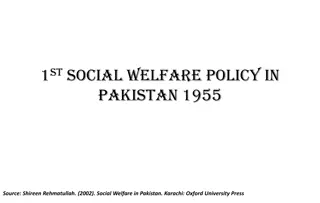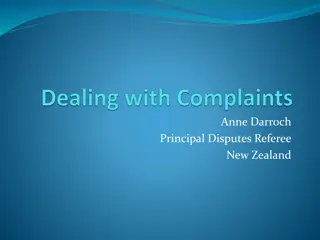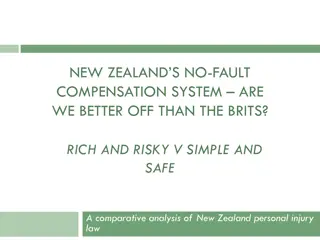Investment’ and New Zealand’s welfare
This content explores the concept of social investment in New Zealand, focusing on its implementation, impact, and challenges. It delves into the benefits, drawbacks, and political dynamics surrounding social investment, offering perspectives from key figures in the field.
Download Presentation

Please find below an Image/Link to download the presentation.
The content on the website is provided AS IS for your information and personal use only. It may not be sold, licensed, or shared on other websites without obtaining consent from the author.If you encounter any issues during the download, it is possible that the publisher has removed the file from their server.
You are allowed to download the files provided on this website for personal or commercial use, subject to the condition that they are used lawfully. All files are the property of their respective owners.
The content on the website is provided AS IS for your information and personal use only. It may not be sold, licensed, or shared on other websites without obtaining consent from the author.
E N D
Presentation Transcript
Corked Wine in a Cracked Bottle? Social Investment and New Zealand s welfare reform in Trans-Tasman context Dr Simon Chapple AUT Policy Observatory & VUW simon.chapple@vuw.ac.nz
Whats good and whats not about social investment in NZ 1. Tomorrow matters, as well as today 2. Joined-up policy making across agencies 3. Use of Big Data to help inform decisions 4. No focus on measuring people s outcomes in making investments, despite rhetoric of their importance 5. Welfare transfers and real resource costs are treated the same 6. All win-wins. Trade-offs between equity and efficiency hidden 7. Flows off a welfare benefit are a good proxy for flows into jobs 8. All jobs are equally valued 9. Spending resources on expensive actuaries rather than measuring people s outcomes
Political architect of social investment in New Zealand When government does its job well and intervenes effectively it enables vulnerable people to increase their resilience and social mobility, and it helps them make positive changes to their lives. It also reduces demand for public services over the medium to long term, and therefore saves taxpayers money. What works for the community works for the government s books. Bill English, former Minister of Finance, current PM, Annual John Howard Lecture to Menzies Research Centre, 2015
The purpose of an investment approach is to make the long-term costs transparent and to guide investments to improving employment outcomes and reducing long-term benefit dependency It is the accompanying social costs that we see alongside the financial costs that are the real concern. Paula Bennett, former Minister of Social Development, now Deputy PM, 2011
The politics of social investment Bill English entered Parliament in 1990 National Party, elected in 1990 under the first past the post uni-cameral system (48% popular vote, 69% seats) Cut welfare benefits and other government spending significantly in 1991 Standard centre-right smaller government Burnt political capital in hope of rapid return Public rebellion, in part due to this budget, led to the introduction of proportional representation Since, no majority government in New Zealand
Centre-right problem: How to achieve goals of reducing the state in an environment of proportional representation and coalition politics? (2014 election, National Party 47% of popular vote) Answer Why did the model cross the Tasman? Centre-right government, similar political constraints The win-win of social investment, with headline rhetorical appeal across the political spectrum
So whats wrong with social investment win-wins? Look at what is being done, not the headline rhetoric from Ministers When the nuts and bolts of NZ social investment are examined, only one win is measured and incentivised It is the fiscal, re-distributional win. Fiscal redistribution is considered a good proxy for social and economic wins
Key unifying feature of the New Zealand social investment approach so far Managing and incentivising the working age welfare system providers in terms of the future fiscal liability At the same time tightening the rules of eligibility and increasing the amount of surveillance of beneficiaries
What is future fiscal liability? The predicted and discounted future costs in the welfare system of those who have been on a benefit over the reference year 80 percent of liability is welfare benefit payments
Where does fiscal liability come from? 2011 Welfare Working Group Lessons from insurance industry Insure against adverse events Now and future premiums from clients (asset), now and future pay-outs to clients (liability), maximise the difference (net worth) How good is the analogy? No asset, only liability Reduce liability by running down the unobserved assets Describing people on welfare as a liability
Fiscal focus: Look where the money is going Amount of money spent on actuaries measuring fiscal liability, 2010 to 2017, probably $10 million NZD> Amount of money spent on measuring outcomes of people subject to social investment policy, virtually zero
Fiscal focus: Look at the governments strategic objectives Better Public Services Goal 1: Reducing long-term welfare dependence , via two measurable targets: Reducing working age client numbers by 25% to 220,000 in 2018 An accumulated actuarial release of $13 billion in 2018 Note neither target is about long-term benefit dependence Actuarial release=estimate of change in fiscal liability from changes in the number of beneficiaries and their likelihood of long-term benefit receipt. isolate[s] the impact of collective Government activity on beneficiary numbers
Fiscal focus: Failure to evaluate welfare reforms, 201- 2015 No evaluation plan, no evaluation, despite being the biggest welfare reform for a generation Argument offered: it is all in the residual fiscal liability change, attributed to reforms and management influence So nothing more need be examined
Fiscal focus: Look at the Social Investment Unit (SIU) Social investment is about improving the lives of New Zealanders by applying rigorous and evidence-based investment practices The SIU has the potential to provide Government with the ability to look across the social sector, and examine particular population groups from a life-course perspective. This will enable a greater focus on the longer-term drivers of fiscal costs, by identifying the connection between some of those cost pressures and particular at-risk groups.
Fiscal focus means perverse systemic incentives Benefit take-up Good jobs, bad jobs, all the same Not everyone leaves benefit to work Overall, inefficient decision making
Table 2: Most working age beneficiaries do not leave the benefit for work, 2004-2016 data on reasons for benefit cancellations More Less than or than one Benefit duration equal to one year year Obtained work 38.6% 27.2% Transferred to another benefit 19.6% 33.3% 52-week reapplication/annual review 1.5% 4.9% Full-time student 10.2% 3.5% No further medical coverage provided 5.6% 3.4% Left New Zealand 2.9% 3.2% Failed obligations/to re-comply 3.1% 2.6% Imprisonment 1.5% 1.9% Excess Income 1.5% 1.3% Other 15.6% 18.7% Total 100.0% 100.0%
Fiscal liability crosses the Tasman Priority Investment Approach Actuarial valuations will be used to track the effectiveness of policy interventions Christian Porter, Minister of Social Services, 2016 Budget DSS Try, Test, Learn Fund, @ $100 million AUD over four years, aims variously to: help people live independently from welfare improve life-time well-being and achieve better outcomes TTL evaluation at the centre of design but it is unclear what outcomes are sought from the interventions and how they are to be valued. No mention of social cost benefit analysis.
Social cost-benefit analysis and the fiscal redistribution model in the welfare system as competing investment models Social cost-benefit analysis Neoclassical public economics The fiscal redistribution model Fiscal accountancy Intertemporal income redistribution to net taxpayers from net beneficiaries within current tax/benefit rules Intellectual origins Efficiency in the use of scarce societal resources at the margin Outcome to optimise Treatment of positive employment outcomes Valued at gross dollar earnings Not valued Income redistribution from net beneficiaries to net tax payers results in significant trickle down efficiency gains Income payments to beneficiaries valued at zero, income losses to net taxpayers are valued dollar for dollar Income accruing to net tax payers is valued, that accruing to net beneficiaries is not. No additional distributional issues A dollar-for-dollar cost. No tax deadweight Treatment of economic efficiency Explicitly efficiency focussed Values income gains to poorer people above those to richer people reflecting declining marginal utility of income Treatment of marginal utility of income Explicit information provided on winners and losers, or explicit distributional weights Treatment of distribution Treatment of welfare benefits Re-distributional. Costed at tax deadweight Treatment of costs At opportunity cost, including tax deadweight At accounting cost. No tax deadweight Treatment of flows over time Inter-temporal discounting to PV Inter-temporal discounting to PV






















